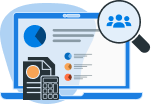What Is the Workforce?
Workforce refers to the group of individuals engaged in work for an organization. It includes everyone from entry-level employees to top executives, each contributing their time, skills, and knowledge toward achieving the company’s goals. The workforce encompasses a diverse set of individuals with varying backgrounds, experiences, and expertise, all working together in harmony.
Workforce management refers to the strategies, practices, and tools used to ensure that the right people are in the right roles at the right time.
Types of Workforce
There are several ways to categorize a workforce based on employment type , job function, and organizational structure:
Full-time Employees
These individuals are typically permanent employees who work a set number of hours each week and are entitled to benefits like healthcare, paid time off , and retirement plans.
Part-time Employees
Part-time workers are those who work fewer hours than full-time employees, often with more flexible schedules. They might not be entitled to the same benefits, but they play an important role in fulfilling specific business needs.
Contract Workers
Contract workers are hired for a specific period or project. They are not permanent employees, and they typically do not receive the same benefits as full-time employees.
Freelancers
Freelancers work on a temporary basis and often on specific tasks or projects. They offer flexibility and specialized skills to businesses but typically work independently.
Interns
Interns are usually students or recent graduates who gain work experience in exchange for educational credits or a stipend. They often perform entry-level tasks while learning about the industry.
Why Is Workforce Management Important?
Workforce management is essential for the smooth operation of any organization. Without an effective workforce management strategy, you might encounter issues like overstaffing, understaffing, poor productivity, or low employee morale. Here are a few reasons why managing the workforce is crucial:
1. Increased Productivity
A well-managed workforce leads to higher productivity. By ensuring that employees are aligned with the right roles and have the necessary tools, you set them up for success. The right workforce management practices help avoid confusion, duplication of efforts, and inefficiency.
2. Cost Optimization
Managing your workforce effectively can help optimize costs. For example, HRMS tools can track employee attendance, overtime, and performance, allowing organizations to make more informed decisions about staffing levels, hiring needs, and resource allocation.
3. Employee Satisfaction
A happy workforce is a productive workforce. When employees feel supported, valued, and aligned with their roles, they are more likely to be engaged and perform well. Workforce management involves ensuring employees are placed in roles where they can thrive.
4. Strategic Growth
As businesses grow, managing a larger workforce becomes increasingly challenging. Having a strong workforce management strategy in place helps organizations scale effectively. By aligning HR strategies with business goals, you ensure that you have the right talent in place to drive growth.
How HRMS Software Supports Workforce Management?
In the digital age, technology has revolutionized how businesses manage their workforce. HRMS (Human Resource Management Software) systems help HR professionals streamline their operations, ensuring that workforce management is as efficient and effective as possible. Here are some of the ways HRMS software plays a vital role:
1. Recruitment and Onboarding
HRMS software allows businesses to streamline the recruitment process by automating job postings , applicant tracking, and even interviews. The system helps HR teams identify and attract the right talent quickly. Once candidates are hired, onboarding is simplified, making the transition into the company smooth for new employees.
2. Employee Data Management
HRMS software centralizes employee data, allowing HR teams to track personal details, performance reviews , career progression, and much more. This data is essential for making informed decisions about promotions, salary adjustments, and development opportunities.
3. Time and Attendance Tracking
Accurately tracking employees' working hours, attendance, and leave is critical for managing labor costs and ensuring compliance with labor laws. HRMS software simplifies this process, reducing errors and improving accuracy.
4. Performance Management
By integrating performance management tools , HRMS systems help managers assess employee performance, set goals, and offer feedback in real-time. This ensures that employees are continuously developing and meeting organizational expectations.
5. Training and Development
HRMS platforms often include features that allow companies to manage employee training and development . By identifying skills gaps and providing employees with learning opportunities, organizations can ensure that their workforce is constantly growing and evolving.
Challenges in Workforce Management
Despite the benefits, workforce management is not without its challenges. Here are some common obstacles organizations face:
1. Communication Gaps
Miscommunication between teams, departments, or management can lead to confusion, inefficiencies, and decreased morale. Clear and constant communication is vital for smooth operations.
2. High Turnover Rates
High turnover can be costly for businesses. It’s important to create a work environment where employees feel valued and engaged to reduce attrition rates.
3. Skill Gaps
As industries evolve, skill gaps can arise. Ensuring that your workforce has the right skill sets for the future requires continuous investment in training and development.
4. Compliance Issues
Workforce management must also comply with local, state, and federal labor laws. Non-compliance can lead to legal troubles and fines, making it important for HR teams to stay up-to-date with regulations.
Best Practices for Workforce Management
To overcome these challenges, here are some best practices for managing your workforce effectively:
1. Use Data to Make Informed Decisions
Using data and analytics tools within HRMS software can help organizations track key performance indicators (KPIs) like employee turnover, productivity, and engagement. Data-driven decisions lead to better outcomes.
2. Provide Opportunities for Growth
Encourage continuous learning and career development . Offering employees opportunities to enhance their skills not only helps them perform better but also makes them more invested in the company.
3. Foster a Positive Company Culture
A positive company culture is crucial for attracting and retaining top talent. Provide a supportive environment, encourage collaboration, and recognize employee achievements to keep morale high.
4. Optimize Scheduling and Resource Allocation
Using workforce management tools like HRMS software can help optimize scheduling, ensuring that you have the right number of employees available during peak hours while avoiding unnecessary costs.
Ready to streamline your workforce management? Learn how Qandle’s HRMS software can simplify HR tasks, enhance productivity, and help you manage your workforce efficiently. Don’t wait to optimize your workforce management—Get started with Qandle HRMS today!


 Back to Glossary
Back to Glossary